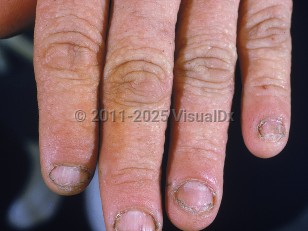People with EV typically first develop warts as young children. The disease is non-remitting and is often disabling. Half of patients with EV will develop a non-melanomatous skin cancer by age 30-40, particularly in sun-exposed areas like the forehead.
There are two main lesion types seen on patients with EV:
- The first type resemble the coalescent scaling patches and plaques of tinea versicolor and can be either hyper- or hypopigmented. They are found on the trunk, neck, and limbs and generally do not become malignant.
- The second lesion type is verrucous and seborrheic keratosis-like in form and found in areas of sun exposure such as the hands, feet, and face. These are the lesions that can become non-melanomatous skin cancers, particularly with sun exposure.
The mutations in EVER1 and EVER2 account for 75% of cases. Recently, mutations in additional genes (RHOH, MST-1, CORO1A, and IL-7) have been described.
Acquired EV, also referred to as secondary EV, is a clinical entity resembling EV that occurs in patients with defective cell-mediated immunity (eg, HIV infection, lymphoma, leprosy, or taking certain immunosuppressive medications). The disease has no sex or age predilection. Cases have been reported in both early childhood as well as in elderly patients.
HPV types 3, 5, 8, 9, 10, 12, 14, 15, 17, 19, 20, 21, 22, 23, 24, 25, 28, 29, 36, 46, 47, 49, and 50 are most commonly seen in EV. The strains with the most potential to engender non-melanomatous skin cancer are HPV types 5, 8, and 14d.



